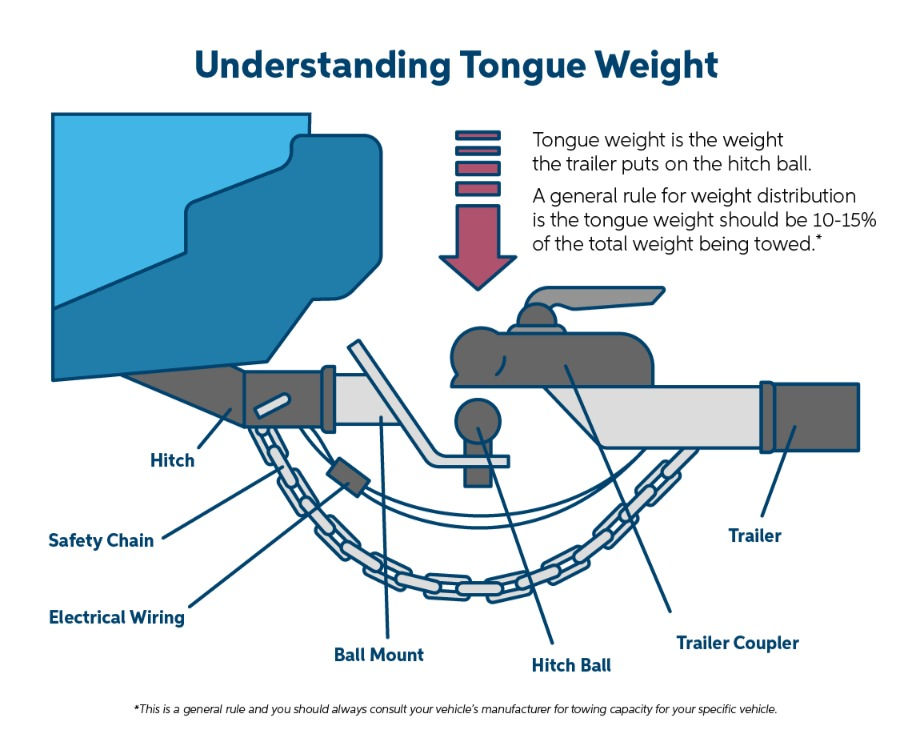

Tips for Hauling
Here are some tips and reminders for safely towing a trailer.




Tow Vehicle - How will you be towing?
While a pull-behind camper can be towed with a properly equipped SUV, a larger gooseneck or fifth wheel requires a pickup truck.
Half-ton, three-quarter, or one-ton? Gas or diesel? Short bed or long? Single or dually? Automakers have identified the needs and offer a variety of models ideally equipped for towing.
Consider the truck and trailer as a towing combination. For the best towing experience, match the capabilities of the truck you own or plan to purchase to the trailer gross vehicle weight.
We recommend the tow vehicle you select have a trailer weight rating to handle at least the Gross Vehicle Weight Rating (GVWR) of the trailer you plan to tow.
Proper weight and load distribution are absolutely essential to safe towing.
Keep the loaded tongue weight between 15% and 25% of the total weight.
Know Your Towing Capacity
Before you start hauling it's best to know the towing capacity of your truck. Towing too much weight you could be damaging the truck by putting strain and stress on the truck’s frame and chassis, resulting in expensive repairs, no matter how big and powerful your engine is.
But, more important, consider the safety factor to yourself and others – finding that your brakes take longer to stop, or possibly even complete brake failure safely.
The first thing to do is to refer to the owner's manual of your vehicle or look for the MFG/VIN Sticker located on your vehicle on the drivers side door or frame. The sticker will show the vehicles GVWR and the owners manual should give you specific numbers regarding how much weight you can tow.
Knowing how much weight your vehicle can tow will keep your ride safe and help you better prepare for loading.








Proper Weight Distribution
If you own or plan to pull a bumper pull trailer with a tongue weight that exceeds your regular hitch's tongue weight capacity; or if you are noticing a dip point between your hitch and receiver, experience trailer sway or find it difficult to steer or stop suddenly while pulling your trailer, you might want to think about getting a Weight Distrubution System.
Weight should be distributed as a 60/40, with 60% of the weight in front of the axle, and 40% behind. Most of the weight of your tow vehicle and your trailer will be carried on the rear axle of your vehicle if not properly distributed causing axle lift and pressure reducing vehicle and trailer control.
Weight distribution trailer hitches work by distributing the tongue weight evenly to the trailer and tow vehicle axles, allowing both to be more parallel with the road. It accomplishes this using spring bars. The spring bars are placed under tension, leveraging down on the trailer frame and therefore lifting up on the back of the vehicle. This tension serves as an opposing force to the downward pressure of the trailer tongue weight, and ultimately keeps the vehicle and trailer level.




Towing Hardware - Choose the Right Hitch
Selecting the appropriate hitch for your truck and trailer combination is crucial for safe and efficient towing. Consider the type of trailer you’re towing, its weight, and your truck’s towing capacity when choosing a hitch. Some hitch types available include:
*Receiver hitches *5th wheel hitches *Gooseneck hitches *Weight distribution hitches
*Pintle hitches
The size of your hitch and other components is also key to ensuring a secure fit.
Different trailers require different tow ball diameters. Generally, standard trailers need a tow ball with about a 2” diameter. Tow balls can be easily changed out as needed for different trailers.
A drop hitch is necessary when a trailer and a coupler don’t reach the same height. You want your trailer to be level, for stability and safety.
Weight Distributing hitch attachment is used to ensure that weight is distributed evenly. That means less sway, more stability, and improved safety. With a weight distribution hitch, you can tow at your hitchs maximum capacity without causing excessive strain.

Enhancing Your Truck's Towing Capability
If you’re looking to get even more out of your truck’s towing capacity, consider upgrading its performance with aftermarket accessories and modifications. Air suspension kits, exhaust systems, and performance chips are some of the options that can help increase towing capacity.
Performance upgrades, such as engine tuning and suspension enhancements, can increase your truck’s towing capacity. Some modifications that can improve your truck’s towing capabilities include:
-
Upgrading the axles
-
Increasing suspension/suspension system
-
Upgrading the brakes
-
Installing a programmer
By investing in performance upgrades, you can ensure your truck is able to handle heavier loads and deliver a better towing experience.
